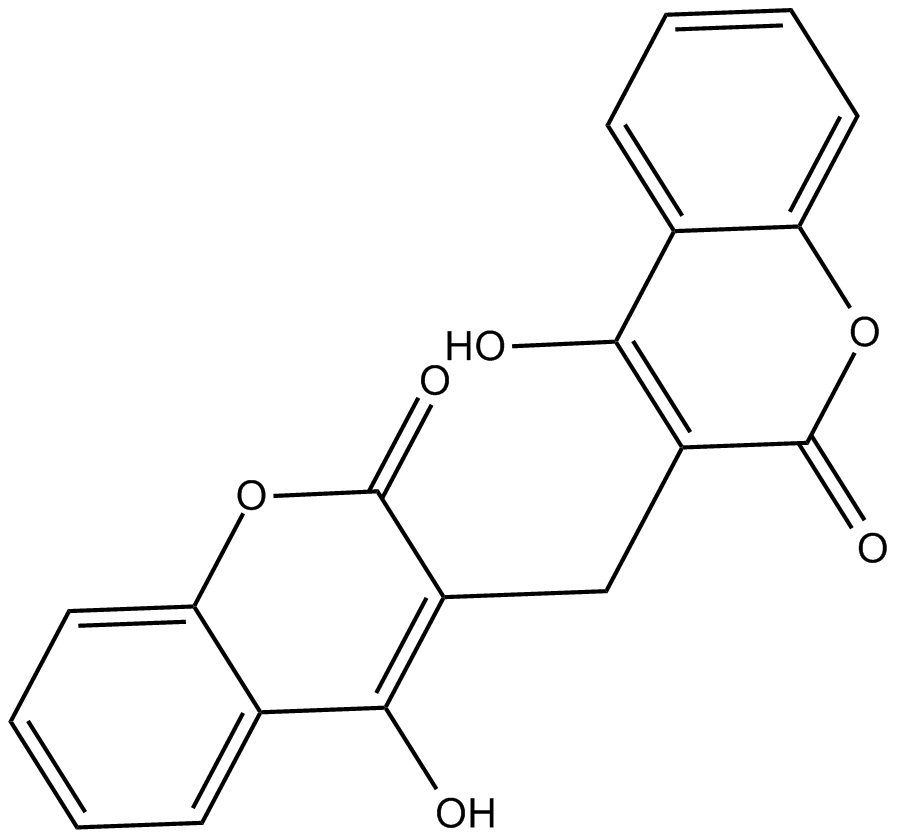Dicoumarol (Synonyms: NSC 17860, NSC 41834, NSC 221570) |
| Catalog No.GC15350 |
competitive NADH quinone oxidoreductase (NQO1) inhibitor
Products are for research use only. Not for human use. We do not sell to patients.

Cas No.: 66-76-2
Sample solution is provided at 25 µL, 10mM.
Dicoumarol is an inhibitor of both NAD(P)H:quinone oxidoreductase 1 (NQO1) and PDK1 with IC50s of 0.37 and 19.42 μM, respectively.
Dicoumarol is an inhibitor of both NAD(P)H:quinone oxidoreductase 1 (NQO1) and PDK1 with IC50s of 0.37±0.15 and 19.42±0.032 μM, respectively. The PDK1 activity is inhibited by Dicoumarol in a dose-dependent manner. The enzymatic activity of PDK1 is reduced by approximately 94% when treated with 200 μM Dicoumarol. Dicoumarol decreases the p-PDHA1 level by 26% (100 μM Dicoumarol) and by 72% (200 μM Dicoumarol), with no statistical difference in the total PDHA1 level. Both 100 μM and 200 μM Dicoumarol markedly induce apoptosis of SKOV3 cells. Similarly, flow cytometric analysis of annexin V+PI+ cells reveals that 100 μM and 200 μM Dicoumarol treatments generate approximately 20.87% and 24.94% apoptotic cells, respectively, significantly higher than vehicle treatment[2]. It is also observed that treatment of MCF-7-TAMR cells with Dicoumarol, a known NQO1 inhibitor, reverses their tamoxifen-resistance phenotype[3].
Dichloroacetate (DCA) at 100 mg/kg, Dicoumarol at 30 mg/kg, and Dicoumarol at 50 mg/kg all significantly reduce tumor volume and decrease tumor weight, when compare to tumors from control or vehicle groups. Total caspase-3 and total anti-poly (ADP-ribose) polymerase (PARP) are significantly decreased in Dicoumarol-treated SKOV3 xenografts, when compare to tumors from the control or vehicle group[2].
References:
[1]. Bian J, et al. Affinity-based small fluorescent probe for NAD(P)H:quinone oxidoreductase 1 (NQO1). Design, synthesis and pharmacological evaluation. Eur J Med Chem. 2017 Feb 15;127:828-839.
[2]. Zhang W, et al. Dicumarol inhibits PDK1 and targets multiple malignant behaviors of ovarian cancer cells. PLoS One. 2017 Jun 15;12(6):e0179672.
[3]. Fiorillo M, et al. Mitochondrial "power" drives tamoxifen resistance: NQO1 and GCLC are new therapeutic targets in breast cancer. Oncotarget. 2017 Mar 2;8(12):20309-20327.
Average Rating: 5 (Based on Reviews and 30 reference(s) in Google Scholar.)
GLPBIO products are for RESEARCH USE ONLY. Please make sure your review or question is research based.
Required fields are marked with *




















